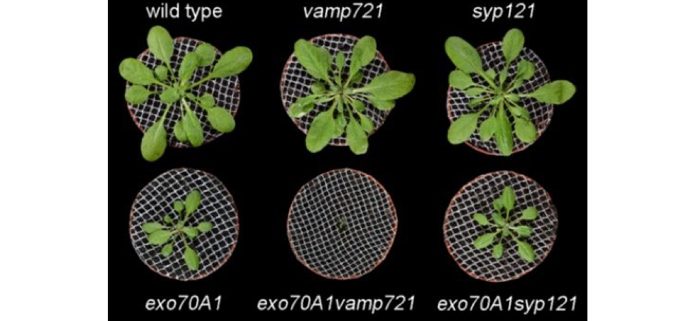Interactions between exocyst and SNARE vesicle trafficking machinery support plant growth
Larson et al. examine the interactions between subunits of the exocyst and SNARE complex and the effects of these interactions on trafficking, secretion, and growth. Plant Cell https://doi.org/10.1105/tpc.20.00280
Emily R Larson1,3, Jitka Ortmannová2,4, Naomi A Donald1, Jonas Alvim1, Michael R Blatt1 and Viktor Žárský2
1 Laboratory of Plant Physiology and Biophysics, Bower Building, University of Glasgow, Glasgow G12 8QQ, United Kingdom
2 Institute of Experimental Botany, Academy of Sciences of the Czech Republic, 165 02 Prague 6, Czech Republic
Current addresses for:
3 Current address: School of Biological Sciences, University of Bristol, Bristol Life Sciences Building, 24 Tyndall Avenue, Bristol, BS8 1TQ, United Kingdom
4 Current address: Uppsala Biocenter, SLU, Department of Plant Biology, PO Box 7080, SE-19 750 07 Uppsala, Sweden
Background: Cells use vesicles to transport cargo throughout the cell and to the plasma membrane, which is critical for plant cell growth and function. Several different proteins help control and regulate vesicle traffic to deliver cellular cargo to its functional locations. During secretion, SNARE proteins located on the vesicle and plasma membrane interact to fuse the two membranes together and deposit the protein cargo. While SNAREs are required for membrane fusion, they rely on other mechanisms to get the vesicles in proximity to their target membranes. The exocyst is a well-studied tethering complex that helps deliver vesicles to the plasma membrane. Although it has been hypothesized that SNARE and exocyst protein complexes work in the same secretory pathways, there is a lack of in vivo evidence of interactions between either protein subunits or complexes in plants.
Question: We hypothesized that there are direct interactions between SNARE and exocyst proteins that support cargo delivery at the plasma membrane, and that these interactions could happen in a sequential manner to regulate vesicle delivery and fusion.
Findings: Using split-ubiquitin yeast mating and FRET analyses, we identified direct interactions between the EXO70A1 exocyst subunit and SNAREs on both the vesicle (VAMP721) and plasma membrane (SYP121). We found that the exo70a1 mutant has reduced secretion, consistent with the redistribution of the vesicle SNARE VAMP721 away from the plasma membrane in the exo70a1 mutant background. These results suggest that the exocyst helps deliver or recruit vesicles to the plasma membrane through its interactions with SNARE proteins. In the syp121 exo70a1 double mutant, syp121 was epistatic to exo70a1 but surprisingly, the vamp721 exo70a1 double mutant had synergistic phenotypes, including severe growth suppression. We believe that these results indicate a functional hierarchy between vesicle and plasma membrane SNAREs and highlight the consequences of these interactions on plant growth.
Next steps: We know the protein domain of VAMP721 that is important for its interactions with EXO70A1, we would now like to know what part of EXO70A1 regulates its interactions with SNARE proteins and how they support the dynamics of vesicle delivery at the plasma membrane.
Emily R Larson, Jitka Ortmannová, Naomi A Donald, Jonas Alvim, Michael R Blatt and Viktor Žárský (2020). Synergy Among Exocyst and SNARE Interactions Identifies a Functional Hierarchy in Secretion during Vegetative Growth. Plant Cell. https://doi.org/10.1105/tpc.20.00280




